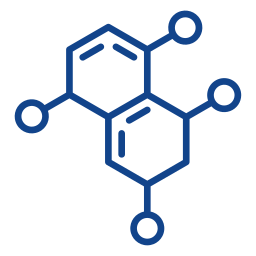-
CaCO3 in Paint and Surface Coatings
Advantages of calcite:
It shows strengthening properties.
Controls viscosity.
Reduces costs by reducing titanium dioxide consumption.
Improves opacity due to high whiteness.
It is reinforcing.
Increases the impact resistance of the paint film.
Provides gloss in paint.
Prevents flow of film paints.
Provides smooth film surface.
It has superior hiding properties.
It has high dispersion feature.
Provides gloss thanks to its large surface area.
Not harmful to health.
Low oil absorption rate.
Provides effective wear protection. -
CaCO3 in the Plastic Industry
Saves dop oil compared to different chemical surface coatings.
Saves pigment due to high whiteness.
Provides flame retardant properties due to its chemical structure.
Increases the printability values of packaging materials.
Provides positive properties on notched impact strengths.
It shows viscosity regulating effect in polymer.
Micronized calcite used as a filler in the plastics industry:
Controlling the rheological properties of PVC Plastisols
Free of heavy metals that cause aging of polymers
High chemical purity
High whiteness to save on expensive white pigments
The milled grains do not agglomerate and do not come together again
High oil absorption
Not absorbing softeners or chemicals used in the formulation
High whiteness and dyeability at high fill rates, which can save on expensive white pigments
Easy to disperse
Does not cause wear and tear on machines
Homogeneous distribution
Increase hardening, surface properties of the final material, impact strength, stability and resistance to aging
Protection against heat thanks to its strengthening effect
Prevents blocking on defective film surfaces
It must be odorless, tasteless and non-toxic.
However, the fact that calcite, one of the most common ways to reduce costs, is an inorganic mineral and the surface tension difference between it and polymers, which are organic materials, has led to the coating of calcite to obtain better physical values. In this context, ground calcium carbonate is subjected to the coating process with stearic acid at different percentages and coated calcite is produced.The advantages that coated CaCO₃ brings to plastic:
Hydrophobic structure,
Low surface energy,
Easy to disperse,
High homogenization,
Increasing some strengths,
Providing brighter and smoother surface formation,
Reduction of machine wear,
It can be listed as increasing machine efficiency. -
CaCO3 in Construction Chemicals Industry
Niğtaş products are used in many construction areas as filler minerals to improve the physical and chemical properties of the product.
High whiteness.
It is structure forming.
It has standard grain distribution in appropriate ASF ranges.
It is a color carrier.
Increases adhesion strength.
Shortens drying time.
It is widely used in terms of providing economical formulation. -
CaCO3 in the Paper Industry
Calcite as a filler and coating pigment in paper production,
High whiteness,
The appropriate refractive index,
Proper grain distribution,
High degree of retention by the paper,
Insolubility in water,
Chemically non-reactive,
Low abrasiveness,
Low cost
Niğtaş provides superior services to this sector for some reasons.
Niğtaş micronized calcite has the technology to produce nano-sized particles to be used in filling or coating in paper, and the high dispersion properties of our micronized and nanometric products produced add many features to the paper thanks to their low abrasiveness. CalciteIt increases the opacity of the paper.
It creates a smooth surface by filling the gaps between the fibers.
It ensures the suitability of the paper for printing with a smooth surface.
It stabilizes the paper dimensions.
Increases paper softness.
Increases printing quality by providing better absorption of ink in the vertical direction.
Reduces the aging feature of the paper.
Provides fullness in the paper.
Allows the paper to absorb the ink better.
It realizes the horizontal distribution of ink on the paper.
It gives whiteness and brightness to paper.
Recently in the paper industry,
The calcite mixture can be prepared at a lower cost. The ability to use more fillers while maintaining the mechanical characteristics of the paper at a reduced cost,
Calcite improves and increases the whiteness of the coating layer,
Reducing the use of materials such as kaolin, cellulose and optical brighteners,
Increased porosity of high quality writing papers without loss of paint gloss
Paper with calcite can retain its whiteness for longer,
It replaces kaolin thanks to its advantages such as getting rid of the environmental pollution caused by the acidic environment that is abandoned due to working in a neutral system. -
CaCO3 in the Glass Industry
Calcite is used as raw material in glass production. In this context, the main materials that will enter the composition of the glass must first of all be cleaned from foreign materials and ground well. In this context, the calcite mineral used in glass production must be of the most suitable size for this process. Thanks to its very low iron oxide content, Niğtaş Calcite ensures that the color of the glass does not deteriorate.
Calcite
It increases the resistance of glass to chemical effects.
Limestone is used as raw material in glass production due to the metal oxides it contains.
Saves heat in glass furnaces.
Increases the hardness of glass.
Provides advantage in terms of cost.
It is thought to be useful in increasing transparency. -
CaCO3 in the Gypsum Industry
Reduces operating costs as it is used as a filling mineral.
It increases the processability of gypsum. Since gypsum has a sticky structure, it cannot move in spirals and sticks. Calcite facilitates the progress in the spiral in machine plaster and provides ease in spraying.
Prevents early freezing of plaster.
It gives softness to the plaster.
Calcite to be used in the gypsum industry;
It has high impurity,
Grain size distribution and grain shape appropriate,
Low moisture content,
The whiteness value should be high. -
CaCO3 in Other Sectors
Ground calcite, also known as calcite natural calcium carbonate, is a raw material input in the food, pharmaceutical, cosmetics and feed sectors as well as in the production of ceramics, carpet backing and linoleum.


















